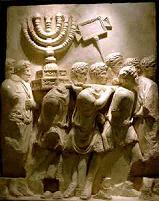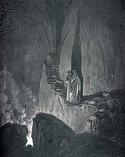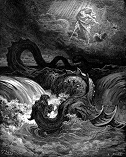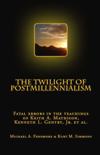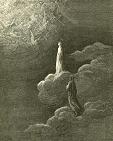Three Views on the Rapture & Change
There are three basic models among
Futurists and Preterists regarding the fate of those alive at
Christ's return.
These are 1) the Literal Rapture view; 2) the Covenantal view;
and 3) the Translation/Change at Death view.
In this article we will briefly survey these views and
conclude that the Translation at Death view is the most
scripturally defensible.
The Literal Rapture View
The view held by the great majority of
Christians is that, at Jesus' return, the dead will be
physically raised to life; those still alive will then be
"caught up" with the resurrected dead, and together
simultaneously translated to heaven. Preterists who believe in
the literal rapture view, reject the physical body resurrection
of the dead, but otherwise agree that the living were
miraculously changed at Christ's return and translated to heaven
in a manner similar to Enoch and Elijah.
Futurists holding the literal rapture view also believe
that Christ's return will mark the end of the physical universe.
Belief in the sudden end of the cosmos is closely related to the
view that the living are to be translated to heaven at Christ's
return, since otherwise they must share the fate of the wicked,
who it is believed will be consumed in the fiery conflagration
that will supposedly end earth's history.
Passages supposed to teach that the earth and wicked will
be consumed in fire at Jesus' coming include I Cor.
I
Cor. 3:12, 13 - "Now if any man build upon this foundation gold,
silver, precious stones, wood, hay, stubble; every man's work
shall be made manifest: for the day shall declare it, because it
shall be revealed by fire; and the fire shall try every man's
work of what sort it is."
II
Thess. 1:7-10 - "And to you who are troubled rest with us, when
the Lord Jesus shall be revealed from heaven with his mighty
angels, in flaming fire taking vengeance on them that know not
God, and that obey not the gospel of our Lord Jesus Christ: who
shall be punished with everlasting destruction from the presence
of the Lord, and from the glory of his power; when he shall come
to be glorified in his saints, and to be admired in all them
that believe (because our testimony among you was believed) in
that day."
II
Pet. 3:10 - "But the day of the Lord will come as a thief in the
night; in the which the heavens shall pass away with a great
noise, and the elements shall melt with fervent heat, the earth
also and the works that are therein shall be burned up."
Rev.
20:9 - "And they went up on the breadth of the earth, and
compassed the camp of the saints about, and the beloved city:
and fire came down from God out of heaven, and devoured them."
It is easy to see how belief in the rapture
or translation of the living fits neatly into view that the
world is to end at Jesus' return.
But what if the language of a fiery end of the earth is
merely figurative and symbolic? What if earth was not to end at
all, but life was to continue in a "new heavens and earth" under
the government of Christ, seated from the right hand of God in
heaven; a "new earth" in which the church is the new Jerusalem,
the covenantal habitation of the saints, which serves as the
capitol city of Christ's earthly kingdom?
Wouldn't that prove most inconvenient to the view that
the living saints were to be borne away to heaven at Christ's
return? One rather suspects it must, for if the church, the
bride, is carried off to heaven, who will inhabit the new
Jerusalem?
Revelation specifically states that "God will dwell with men"
(Rev. 21:3). If the
city has been depopulated by the rapture of the saints, with
whom would God dwell?
The symbolic nature of the language underlying belief in
the fiery end of the universe at Christ's return was early on
pointed out by Origen (AD 184-254):
"The
divine word says that our God is ‘a consuming fire,’ and that
‘He draws rivers of fire before Him;’ nay, that he even entereth
in as ‘a refiner’s fire, and as a fuller’s herb,’ to purify His
own people. But when He is said to be a ‘consuming fire,' we
inquire what are the things which are appropriate to be consumed
by God? And we assert that they are wickedness, and the works
which result from it, and which, being
figuratively
called ‘wood, hay,
stubble,’ God consumes as a fire.
The wicked man, accordingly, is said to build upon the
previously-laid foundation of reason, ‘wood, and hay, and
stubble.’ If, then,
any one can show that these words were differently understood by
the writer, and can prove that the wicked man
literally
builds up ‘wood,
or hay, or stubble,’ it is evident that the fire must be
understood to be material, and an object of sense. But if, on
the contrary, the works of the wicked man are spoken of
figuratively,
under the names of ‘wood, or hay, or stubble,” why does it not
once occur (to inquire) in what sense the word ‘fire’ is to be
taken, so that ‘wood’ of such a kind should be consumed? For
(the scripture) says: “The fire will try each man’s work of what
sort it is. If any man’s work abide which he hath built
thereupon, he shall receive a reward. If any man’s work be
burned, he shall suffer loss.”[1]
If the fire that was to consume the wicked
and their works at Christ's return was not literal, and the
wicked (Jews and Romans persecuting the church) died of "natural
causes" (war, famine, pestilence) resulting from God's
super-mundane visitation and judgment, would it not therefore
follow that the righteous also departed earth by natural causes?
Why would there be a miraculous translation of the living saints
if earthly life was to continue as before? Yes, why?
For futurists, belief in the sudden end of the world and
rapture of the living are logically and necessarily connected,
for if there is no rapture, then the righteous must be consumed
in the conflagration that destroys the wicked. But for
Preterists, who reject the notion that earth was to end in a
fiery conflagration, there is a logical gap; there is no reason
provided why they should be whisked away from earth. That said,
let us turn to the passages relied upon in support of a literal
rapture. These include I Cor. 15:50-52; I Thess. 4:13-17; Phil.
3:21; I Jn. 3:2.
I
Cor. 15:50-52 - "Now this I say, brethren, that flesh and blood
cannot inherit the
There are three possible interpretations of
this passage: 1) It teaches the
actual translation of
the living to heaven at Christ's return; 2) the "change" is
legal and covenantal; viz.,
the passage is figurative;
3) the change occurs later
than the general resurrection;
viz., at the
individual's death.
My Wrong Turn into "Covenantalism"
Most Preterists reject the actual
translation or rapture of the living as lacking historical
support and running against their better interpretative
instincts. Hence,
many Preterists have sought refuge in a spiritualized view,
which interprets the change "covenantally."
This is the view I took for many years, but recently was
forced to abandon. Faced with the language of the passage that
appears to require the change of the living occur
simultaneously with
the general resurrection of the dead, and at a loss how
otherwise to explain in what way the living then put on
incorruption and immortality (v. 54), I adopted the covenantal
view. Although I never accepted the covenantal view of the
resurrection many fellow Preterists were teaching, the lack of
alternatives regarding the "change" forced me to adopt that
approach here. Specifically, I took the view that
putting on immortality
here was equal to
justification from sin, which I supposed was in some form or
manner held in abeyance during the
betrothal period from the cross to AD 70, when the marriage
of the Lamb and bride was
consummated at Christ's coming.
For some years, I had begun noticing many
discrepancies in the covenantal approach as applied to other
areas of eschatology.
For example, the covenantal approach sees the second
coming as essentially a "local" Judean event, focused on the
fall of Jerusalem and the supposed termination of the Old
Testament, when in fact many passages show that the Old
Testament ended at the cross and Christ's coming was
"world-wide" (Gk. oikumene,
inhabitable earth), enveloping most of the Roman Empire.
But as Christ's coming
against Rome and the provinces of Europe and Asia Minor does not
fit the covenantal paradigm, having no significance in terms of
the change from the Old Testament to the New, this inconvenient
fact, so plainly taught in scripture, is simply overlooked (Ps.
2:8, 9; 110:5, 6; Dan. 2, 7; Haggai 2:22).
This and many other discrepancies caused me
to question the validity of the covenantal approach as applied
to the "change."
After all, if it was false in other areas, why should it be true
here? One of the
passages that finally caused me to abandon that view entirely
was Eph. 5:25-27, which teaches that the bride was washed and
justified from sin during
the betrothal period, so that Christ could present it to
himself pure and without spot at the consummation. Obviously, if
the church was washed from sin during the betrothal period, the
idea that justification was held in abeyance until the
consummation at AD 70 is false. Therefore, the consummation was
not the point at which
the New Testament came into force and sins were remitted, which
actually occurred at the cross (Heb.
One Trumpet or Two?
That is
the Question!
It is a basic premise of Preterism that the
general, Hadean resurrection occurred in A.D. 70.
The simplest most direct proofs of this proposition are
Daniel 12:2, 7, and Rev. 11:2, 15-18, both of which place the
resurrection at the fall of
|
I Cor. 15:52 |
|
I Thess. 4:16 |
|
Rev. 11:15-18 |
|
|
|
|
|
And
the seventh angel sounded; and there were great voices
in heaven, saying...the nations were angry and thy wrath
is come, and the time of the dead, that they should be
judged, and that thou shouldest give reward unto thy
servants the prophets, and to the saints, and them that
fear thy name. |
The mistranslation of the almost all
English Bibles gives the impression that there is
but one trumpet in I
Cor.
|
Authorized (King James) Version |
|
Green's Literal
Translation |
|
Behold, I show you a mystery; We shall not all sleep,
but we shall all be changed, in a moment, in the
twinkling of an eye, at the last trump: for the trumpet
shall sound, and the dead shall be raised incorruptible,
and we shall be changed. |
|
Behold, I speak a mystery to you: indeed we shall not all sleep, but we shall all be changed, in a moment, in a glance of an eye, at the last trumpet; for a trumpet will sound, and the dead will be raised in corruptible, and we shall all be changed. |
The difference in these translations is the
addition of the definite article "the" in the KJV, to reflect
the translators' assumption that the trumpet, which raises the
dead, is the same as the last trumpet that marks the change of
living. However, the
Greek does not have the definite article, as reflected in
Green's literal translation. As used in the KJV, the definite
article attached to the trumpet that raises the dead is
referential; it points
back the last trumpet that changes the living:
"We
shall all be changed…at the last trumpet: for [←] the trumpet
shall sound and the dead shall be raised and we shall be
changed."
Thus, the trumpet that raises the dead is
assumed to be the same
trumpet that changes the living; the definite article points
back to the trumpet
mentioned in the preceding clause.
This use of the definite article is very common in
scripture; where it occurs, it always points
back to the first
occurrence of the thing referred to. Here are a couple examples:
- Rev. 12:3 - "And there appeared another wonder in heaven; and behold a great red dragon.
- Rev. 12:4 - "And the dragon stood before the woman which was ready to be delivered."
- Rev. 12:7 - And there was war in heaven: Michael and his angels fought against the dragon; and the dragon fought and his angels."
- Rev. 13:2 - "And the dragon gave him his power, and his seat, and great authority."
- Rev.13:11 - "And he had two horns like a lamb, and he spake as a dragon."
In the first passage we are introduced to
"a dragon." Since
this is the first appearance of this character, he is introduced
with the indefinite article "a" ("a great red dragon").
However, all subsequent references to this dragon use the
definite article "the" ("the dragon"). Thus, in Rev. 12:3, the
indefinite article introduces the dragon, but in vv. 4, 7, and
13:2, the definite article is employed to show the same dragon
is in view. But
notice Rev. 13:11.
Here the indefinite article is employed. The earth-beast looks
like a lamb, but speaks like "a dragon."
The absence of the definite article shows the word
"dragon" in this instance does
not point back to the "great red dragon" of earlier mention.
The same dragon is not in view. The earth-beast speaks dragon-like
generally, without
reference to the great red dragon
specifically.
Compare this with I Cor. 15:5: the absence
of the definite article shows that the same trumpet is
not in view.
The translators have supplied the definite article,
making the trumpet that raises the dead appear to be the same
trumpet that changes the living.
But the Greek does not have the definite article, showing
that it is not the
same trumpet. "We
shall all be changed…at the last trumpet…for a trumpet will
sound and the dead shall be raised incorruptible, and we shall
be changed (at the last trumpet that calls each us out of this
world at physical death)." We have added the paraphrase at the
end of the verse to help understand what we are proposing;
viz., that there are two trumpets contemplated by the passage: one
that raised the Hadean dead and another that calls each of us
out of this world at physical death.
|
I Cor. 15:52
Two Trumpets |
||
|
The Last Trumpet
Calls the living out of
world at physical death, when they are thus changed and
go to be with the Lord in heaven. |
|
The Voice of the
Raised the Hadean dead at
Christ's
Second Coming |
In support of what we are saying, consider
that the "we all" who are to be changed includes you and I who
live on this side of the eschaton.
There is no limitation on the last trumpet placed by
Paul. Paul does not
say "we who are alive when
Christ returns shall be changed." That is the assumption
some make, but the passage never says this at all.
Why would those alive when Christ returned be wafted out
of the world if the earth was not going to be destroyed?
If life on earth was to continue, why limit the "change"
to those alive at Christ's return?
Futurists have a logical reason to limit the "change" to
those alive at Christ's coming since by their view the world is
to end. Preterists have no similar justification.
They assume the "change" applies only to those alive at
the general resurrection, but can provide no logical explanation
why this should be so.
Thus, Preterists who argue a literal rapture borrow the
Futurist paradigm with none of the logical suppositions to
support their view.
In fact, what Paul says is that "we all (those who do not sleep
in Hades) will be changed." "We
all" includes us alive today!
There is no qualifying phrase limiting this to the
distant past. Has
Hades been destroyed? Yes!
Will we sleep in Hades?
No. What then
is to be our fate at death?
We will be changed! If natural death marks our change,
would not natural death have marked the change of those alive
when Christ returned?
Of course it would (to be absent from the body is to be
present with the Lord, II Cor. 5:6-8).
Natural death was also the way the wicked departed this
world. Thus, there is no
model that supposes a supernatural departure.
Moreover, if the change of the righteous was preceded by
the "last trumpet" calling them out of this world, will not our
change be preceded by the last trumpet as well?
We believe it will.
Such at least is the solution we offer for the passage.
More Passages Relied upon for a Literal Rapture
I
Thess. 4:16, 17 - " For
the Lord himself shall descend from heaven with a shout, with
the voice of the archangel, and with the trump of God; and the
dead in Christ shall rise first: Then we which are alive and
remain shall be caught up together with them in the clouds, to
meet the Lord in the air: and so shall we ever be with the
Lord."
The assumption underlying this passage is
that the catching up the living is contemporaneous with the
resurrection of the dead.
But this assumption cannot be proved.
Paul says the dead would be raised first, "then" those
who are alive and remain, will be caught up together with the
risen dead into ethereal realms above.
The word "then" shows that the catching up is
subsequent to the
resurrection of the dead. How long afterward cannot be
determined by the passage.
But if the living are changed
subsequent to the
trumpet that raises the dead, doesn't this prove that the
trumpet that raises the dead is not the same as the "last
trumpet" that marks the change of the living?
Of course it does!
Where I Cor.
But to return to I Thess.
Phil.
3:20, 21 - "For our conversation is in heaven; from whence also
we look for the Saviour, the Lord Jesus Christ; who shall change
our vile body, that it may be fashioned like unto his glorious
body, according to the working whereby he is able even to subdue
all things unto himself."
This verse does not say that the change would occur at Christ's second coming. That is the assumption many make, but the passage never actually says this. In fact, the passage does not mention Christ's coming at all! It merely says that Christians look for the Savior, who will change their bodies. Will the Savior change the bodies of those who live on this side of the eschaton? Yes, of course. At what point will that change occur? Physical death. But if the our change occurs is physical death, then that is also the time at which we look for Christ our Savoir to affect the needed change, not second coming.
I Jn.
3:2 - "Beloved, now are we the sons of God, and it doth not yet
appear what we shall be: but we know that, when he shall appear,
we shall be like him; for we shall see him as he is."
Those who cite this verse as proof of a
rapture assume that it describes the change of the believer's
body that would occur at Christ's coming.
But the passage actually says none of this.
Although adoptive sons of God, the saints could only
imagine the "powers of the world to come" (Heb. 6:5) that would
be theirs in the resurrection.
However, the power of Christ at his coming against his
enemies (Jews and Romans) would show believers "what we shall
be." At Jesus'
appearing, they would "see" him as he is in power and glory, and
thus see what was in store for themselves, for "we shall be like
him" (cf.
History: A Final Objection to the Literal Rapture View
A final objection to the notion of a
literal rapture is the complete lack of historical support.
Could hundreds of thousands of believers simply vanish
from earth and no mention of it appear anywhere in history?
Surely, that is asking too much.
The only "gathering" of the righteous portrayed in
scripture is the harvest of the saints by martyrdom under Nero
(14:9, 13-16; cf. Matt.
The lack of historical corroboration is
compounded by an abundance of testimony showing the historical
continuity of the church.
Where we would expect a "hole" in history had a rapture
occurred, we find instead complete continuity. For example,
Jesus said some of those alive during his ministry would live to
see his kingdom come in power, which could hardly be the case if
the church was whisked out of the world (Matt. 16:27, 28).
Moreover, Jesus specifically named John as one who would
live to his return (Jn.
The fourth century church historian,
Eusebius, gives an account of the church from its beginning.
Eusebius describes the "apostolic succession" of the
church, providing the names and records of those who lived
through the various persecutions and the destruction of
"After the martyrdom of James and the capture of Jerusalem which
immediately followed, the story goes that those of the Apostles
and of the disciples of the Lord who were still alive came
together from every place with those who were, humanly speaking,
of the family of the Lord, for many of them were then still
alive, and they all took counsel together as to whom they ought
to adjudge worthy to succeed James, and all unanimously decided
that Simeon the son of Clopas, whom the scripture of the Gospel
also mentions, was worthy of the throne of the diocese there. He
was, so it is said, a cousin of the Savoiur, for Hegesippus
relates that that Clopas was the brother of Joseph."[2]
Eusebius also gives the succession of the
bishopric of
"And
all the presbyters who had been associated in
This testimony, provided by Irenaeus, is
echoed by Clement of Alexandria:
"For
after the death of the tyrant he passed from the island of
Patmos to Ephesus, and used also to go, when he was asked, to
the neighbouring districts to the heathen, in some places to
appoint bishops, in others to reconcile whole churches, and in
other to ordain some one of those pointed out by the Spirit."[5]
Thus, the testimony of history accords
fully with scripture that "some of those standing here shall not
taste of death until they see the Son of man coming in his
kingdom" (Matt.
The Covenantal View
This view has it that the resurrection and
"change" of I Cor. 15:51-52 are "covenantal," having reference
to the change from the Old Testament to the New Testament, and
the resurrection and translation of the saints from Judaism to
Christianity. Putting on incorruption and immortality is
spiritualized and equated with justification from sin:
"Paul
wanted to attain unto the resurrection of the dead (ek nekron,
out of the dead) or from the among the dead as represented in
the Jewish system…Phil. 3:21 deals with the resurrection of the
body or the church from the Jewish body into its heavenly
inheritance at the fall of Judaism."[6]
"But
how was death swallowed up in victory? The answer is quite
obvious. Where was death resident? Did it not reign in the
mortal or natural body of Judaism? Paul calls it the
'ministration of death.' But when that body died, and from it
arose a spiritual body clothed with incorruption and
immortality, death was defeated."[7]
"Paul
wanted to attain unto the resurrection of the dead as
represented in the Jewish system?"
This is perfect folly.
How can anyone ask us to take anything so absurd
seriously? It
insults our intelligence to put such a notion forward.
Paul was crucified with Christ to the world, including
especially Judaism (Gal.
"He
taketh away the first, that he may establish the second. By the
which will we are sanctified through the offering of the body of
Jesus Christ once for all...For by one offering he that perfect
for ever them that are sanctified" (Heb. 10:9-14).
Sanctification, justification,
reconciliation, atonement, and if there be any other word or
phrase describing man's being set in a right position with God,
all happened at the cross, not AD 70.
Thus, the "covenantal" view of the resurrection and
change must be rejected as hopelessly at odds with scripture.
The Translation/Change at Death View
All Preterists universally admit is correct
today; all concede that at death the saints now receive their
immortal body and are translated to heaven. The only question is
what happened at Christ's coming in AD 66-70? Was there a
special rapture or covenantal change?
On both counts we feel the evidence says "no."
Thus, what is universally agreed to be true today must
also have been true then: The translation/change came only after
physical death. Of
the two or three verses that appear to teach a rapture, only I
Cor.
I Cor. 15:51 has always been a difficult
passage because the mistranslation of the text makes the
"change" appear simultaneous with the resurrection of the dead,
by making it appear that only one trumpet is mentioned.
However, short of a "delayed reaction" in the trumpet
that raises the dead in I Thess. 4:16 cannot be the same trumpet
that catches the living away from earthly life.
Hence, we submit that the last trumpet that calls each of
us out of this world at physical death is not the same trumpet
that would mark the resurrection of the Hadean dead. The Greek
certainly allows for this, although our mistranslated English
Bibles do not. If
this is not the solution to the passage, then perhaps another
solution will suggest itself at a later time. In the meanwhile,
given that all Preterists agree that the saints are now changed
and translated at death, we have no hesitancy in recommending to
you that what is true now, was also true then.
Indeed, do not Jesus' own words require it? "Verily I say
unto you, there be some standing here, which shall not taste of
death, till they see the Son of man coming in his kingdom" (Mat.
Conclusion
Of the three views of the rapture, only the
"translation/change at death" model cannot be excepted to.
The "covenantal" model is
hopeless at odds with the cross, and the "literal rapture" view
cannot be squared with history.
[1]
Contra Celsus,
IV, xiii; Ante-Nicene Fathers IV, pg. 502.
For an article showing Origen was a Preterist,
see our article
http://www.preteristcentral.com/Origen%20Was%20a%20Preterist.html#_ftn16
[2] Eusebius, Ecclesiastical History, III, xi; Loeb edition.
[3] Ibid, III, ii; III, iv, III, xv
[4] Ibid, III, xxiii.
[5] Ibid.
[6] Max R. King,
The Spirit of
Prophecy (1971,
[7] Max R. King,
The Spirit of
Prophecy (1971,
To receive Kurt Simmons’ e-mail newsletter, The Sword & The Plow, click the Subscribe link:
All rights reserved.
